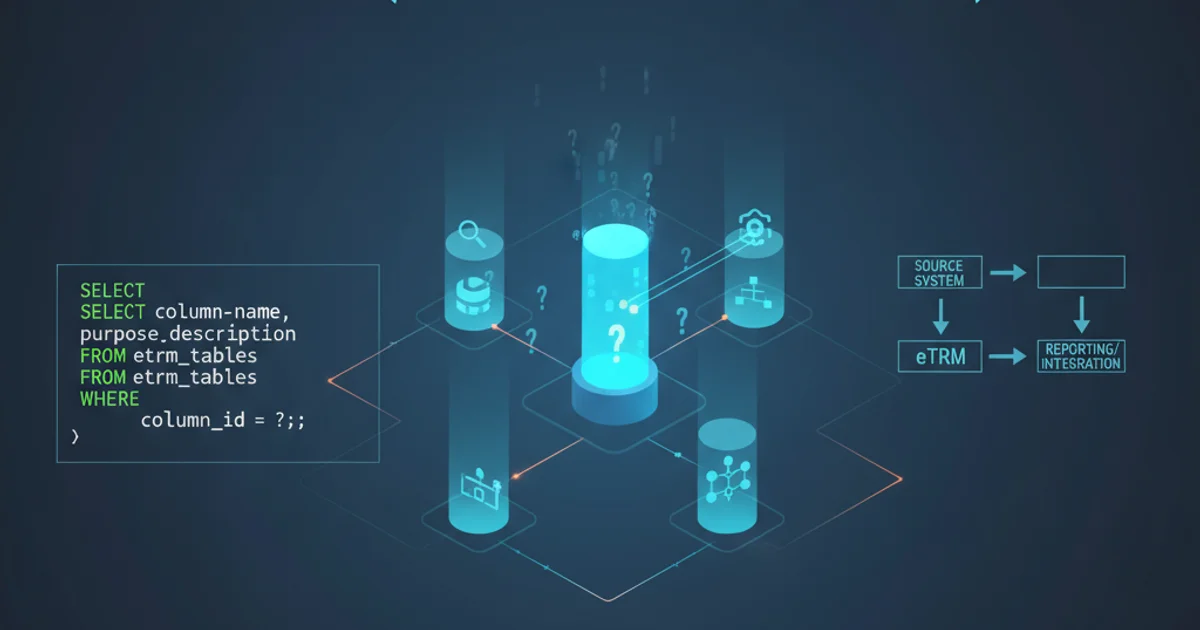What might be the purpose of this column in eTRM (Oracle eBusiness suite)
Categories:
Unraveling the Mystery: Understanding 'Purpose' Columns in Oracle eTRM

Explore the common roles and significance of 'purpose' or 'usage' columns within Oracle E-Business Suite's eTRM (Electronic Technical Reference Manual), helping developers and analysts decipher their meaning and impact on system functionality.
When navigating the vast and intricate schema of Oracle E-Business Suite (EBS) through the Electronic Technical Reference Manual (eTRM), developers and functional analysts often encounter columns with names like PURPOSE, USAGE, ATTRIBUTE_CATEGORY, or similar. These columns, while seemingly generic, play a crucial role in defining the context, behavior, or specific application of a record or entity. Understanding their intent is key to correctly interpreting data, customizing the system, or troubleshooting issues.
Common Interpretations of 'Purpose' Columns
The exact meaning of a 'purpose' column can vary significantly depending on the specific Oracle module (e.g., Financials, SCM, HRMS) and the table it resides in. However, several common patterns emerge across EBS. These columns often act as discriminators, categorizers, or flags that influence how other data in the record is processed or displayed.
flowchart TD
A[Start: Encounter 'PURPOSE' Column]
A --> B{Identify Table/Module};
B --> C{Check eTRM Description};
C -- "Clear Definition" --> D[Understand Specific Use Case];
C -- "Vague Definition" --> E{Examine Data Values};
E --> F{Correlate with Application Behavior};
F --> G[Infer Purpose/Meaning];
G --> H[End: Column Understood];Flowchart for deciphering the meaning of a 'purpose' column in Oracle eTRM.
Here are some typical scenarios where such columns are used:
1. Contextual Discriminator
Many tables serve multiple functions. A PURPOSE column might differentiate between various types of records within the same table. For example, a GL_JE_HEADERS table might use a JE_CATEGORY column to distinguish between 'Manual Journal', 'Payables Invoice', 'Payroll', etc.
2. Configuration Flag
These columns can act as flags that enable or disable certain functionalities or dictate how a record behaves in different processes. For instance, a USAGE_TYPE column in a setup table might determine if a particular configuration applies to 'Internal' or 'External' transactions.
3. Descriptive Flexfield (DFF) Context
A very common use case, especially for columns like ATTRIBUTE_CATEGORY, is to define the context for Descriptive Flexfields. When a specific value is present in this column, a different set of DFF segments (additional custom fields) becomes visible and applicable to the record. This allows for context-sensitive data capture.
4. Reporting and Analytics Categorization
Sometimes, these columns are primarily for reporting purposes, allowing users to categorize and filter data based on its intended use or nature. This helps in generating more meaningful reports and analyses.
Practical Approaches to Deciphering 'Purpose' Columns
When the eTRM description for a 'purpose' column is not immediately clear, a combination of investigation techniques can help you understand its role.
Query Distinct Values: The first step is often to query the distinct values present in the column. This gives you an idea of the possible categories or states it represents.
SELECT DISTINCT purpose_column_name FROM your_schema.your_table_name;Correlate with Application UI: Once you have the distinct values, try to find where these values manifest in the Oracle EBS application's user interface. Create or modify records in the application and observe how different selections for a field correspond to the values in your 'purpose' column.
Examine Related Code/Packages: For developers, searching the underlying PL/SQL packages, forms, or reports that interact with the table can reveal how the 'purpose' column is used in business logic. Look for
WHEREclauses orIFstatements that reference the column.Consult Functional Experts: Functional consultants or power users who are deeply familiar with the specific module can often provide immediate insights into the business meaning and implications of these columns.
SELECT
t.purpose_column_name,
COUNT(*) AS record_count,
MIN(t.creation_date) AS earliest_record,
MAX(t.last_update_date) AS latest_record
FROM
your_schema.your_table_name t
GROUP BY
t.purpose_column_name
ORDER BY
record_count DESC;
SQL query to analyze the distribution and age of records based on a 'purpose' column.
Understanding these 'purpose' columns is not just about technical curiosity; it's about gaining a deeper insight into the design principles of Oracle EBS, enabling more effective customization, integration, and maintenance of the system.